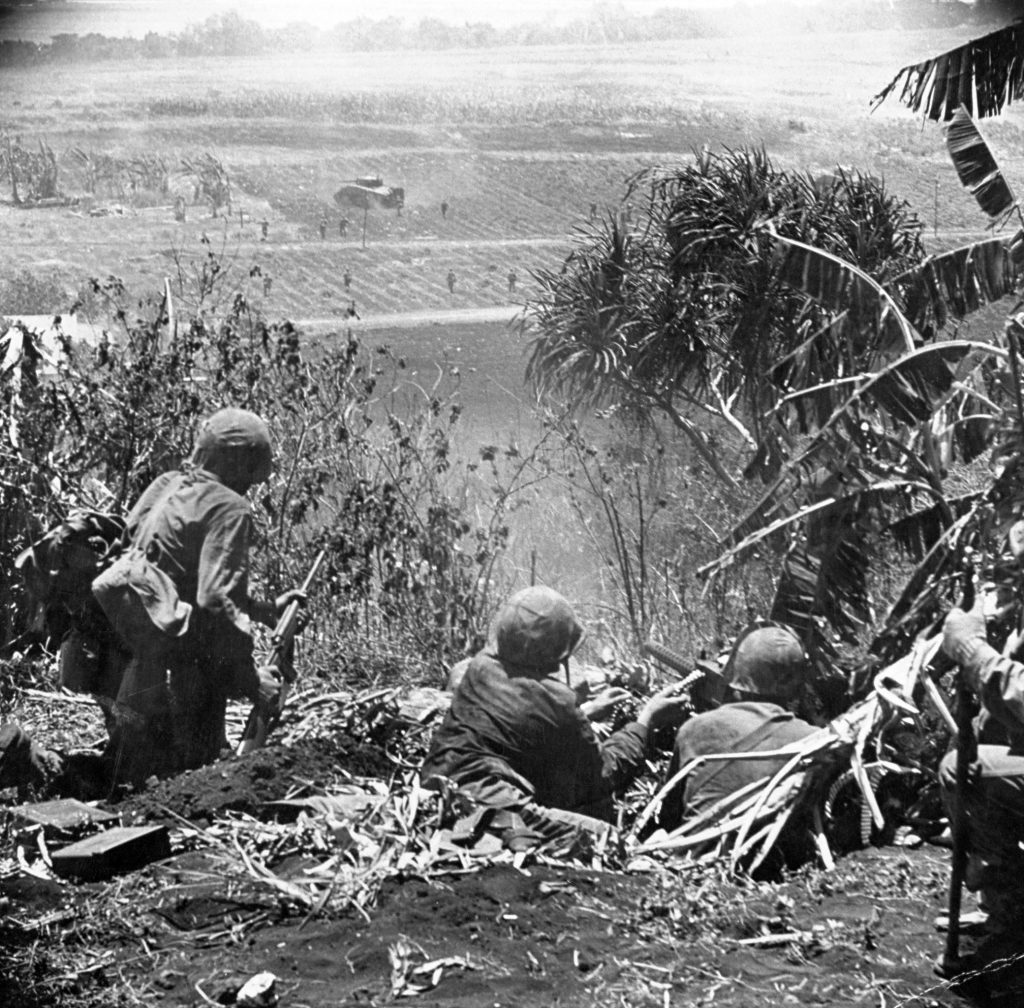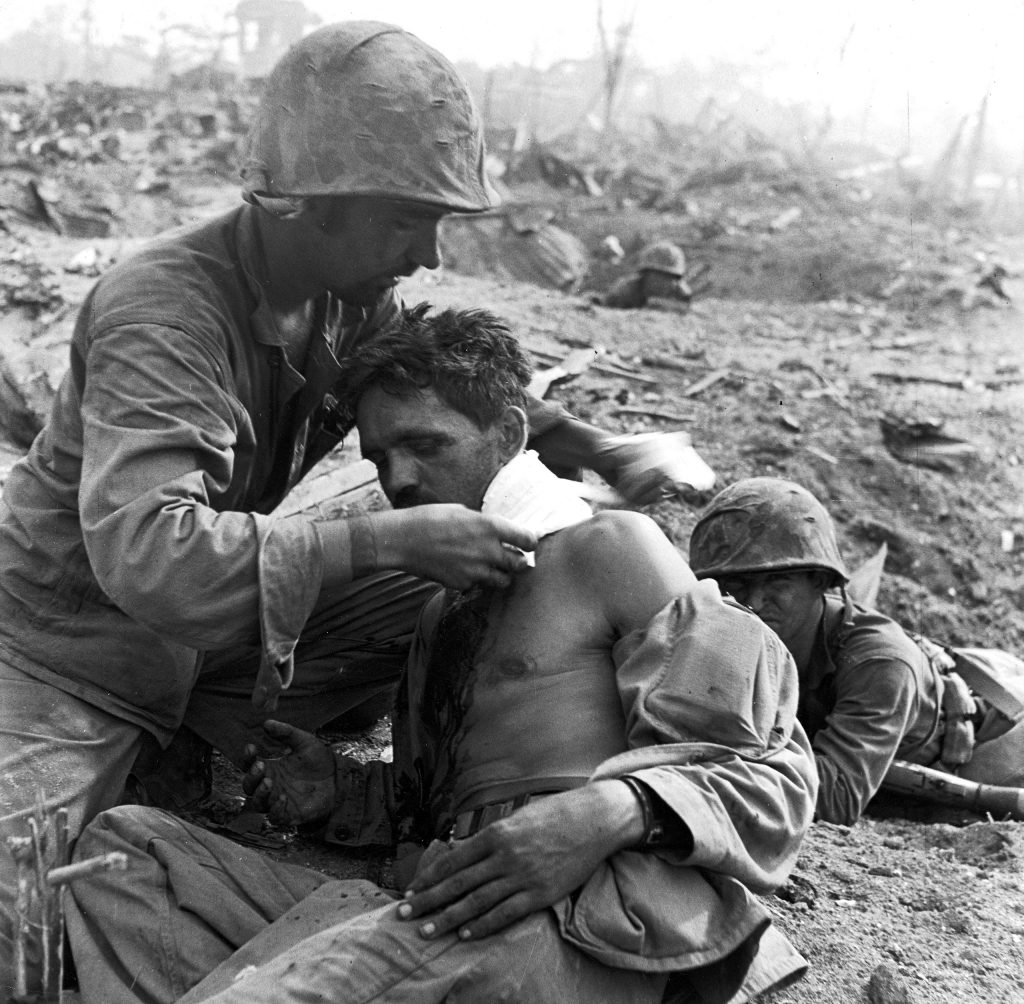Written By: Lily Rothman, Liz Ronk
When U.S. forces came to Saipan on June 15, 1944, the island’s strategic significance was clear: at just about 1,500 miles from Tokyo, it could serve as a staging ground for a full-on American attack on Japan. As LIFE pointed out in its coverage of the battle, American warships in the Pacific had to return to Hawaii—nearly 4,000 miles away—each time they needed supplies. A victory in Saipan would mean those long trips would no longer be necessary.
The problem with Saipan, for American forces, was not that victory there seemed doubtful. The problem was that it would come at a high cost. The terrain offered Japanese forces the advantage of numerous hiding places, and the ongoing fighting—the battle lasted nearly a month, by most counts, though some holdouts continued to fight much longer—concluded in suicide attacks by Japanese forces, as well as mass suicides among the civilian population.
Photographer W. Eugene Smith, sent by LIFE to capture the battle, described what he saw in a note that accompanied his photos as “some of the worst terrain that Yanks have ever been called upon to dislodge an enemy from.” Those notes were adapted into captions but not published in the magazine. They have been maintained in the decades since in the LIFE archives.
One of the most famous photographs Smith took on this assignment was an image of American troops rescuing a baby who had been found in a cave full of dead bodies. As Smith described the discovery in his notes, it came amidst a two-day mission during which troops searched for a cave in which scores of people were rumored to be hiding. Hours spent scouring the region produced only cave after cave of dead bodies. “The stench was vile and the flies and maggots were there by the millions,” Smith noted. “The heat was intense.”
The first living person the Americans found was the baby, “a ‘living-dead’ tiny infant” as Smith put it.
The baby had somehow become stuck, face-down on the ground, with its head behind a rock. Because the ground and the rock were not smooth, however, enough air circulated for the baby to be able to breathe. The search troops heard the baby crying, writhing on the ground struggling to free himself. “It took 5 minutes of careful removal of the dirt to free the head. [The baby] was passed down from hand-to-hand until it reached ground level,” Smith wrote. “Then it was rushed to a hospital by Jeep and we continued our search. No adults who were alive had been found.”
It was the following day that the long-sought cave was located. The American forces used smoke to flush out 122 civilians. The small number of soldiers who remained in the cave were said to have killed themselves rather than surrender.
As for the civilians, they were given water and medical attention, Smith reported. The scene, coming as it did after a grisly run of days, clearly left him with a feeling of hope that was rare in that time. “The soldiers who had lost so many comrades due to the same caves now showered them (especially the kids) with candy or anything else they had,” he wrote. “It was a magnificent example of fair play and lack of a blinding hatred such as can overcome decency and reason. This was real Americanism.”

Marines followed tanks against the last Japanese defenders with machine gunners providing cover. Three men alongside the photographer were hit just before he took the picture.
W. Eugene Smith The LIFE Picture Collection/Shutterstock

A U.S. Marine rested behind a cart on a rubble-strewn street during the battle to take Saipan from occupying Japanese forces.
W. Eugene Smith The LIFE Picture Collection/Shutterstock

Battle of Saipan, 1944.
W. Eugene Smith The LIFE Picture Collection/Shutterstock

A medic tended to a wounded soldier during a fierce battle to take Saipan from occupying Japanese forces.
W. Eugene Smith The LIFE Picture Collection/Shutterstock

The one living person among the hundreds of corpses in one cave was this fly-covered baby who almost smothered before soldiers found him and rushed him to hospital.
W. Eugene Smith The LIFE Picture Collection/Shutterstock

A contact sheet with scenes from the Battle of Saipan.
W. Eugene Smith The LIFE Picture Collection

Some civilians found safety from bombs and shells in the island’s many caves.
W. Eugene Smith The LIFE Picture Collection/Shutterstock

Dust from a nearby explosion caused this mother and son to scamper from a cave. Many believed Japanese propaganda which told them that they would be killed if captured.
W. Eugene Smith The LIFE Picture Collection/Shutterstock

An exhausted Marianas Island father with a wounded child after his capture by (or surrender to) Americans during battle between U.S. and Japanese forces for control of Saipan.
W. Eugene Smith The LIFE Picture Collection/Shutterstock

Native civilians fled ruins of a village during the fighting between Japanese and American forces for control of Saipan.
W. Eugene Smith The LIFE Picture Collection/Shutterstock

Contact sheet with scenes from Battle of Saipan.
W. Eugene Smith The LIFE Picture Collection

An American soldier pointed a rifle into a bunker during fighting in the final days of the invasion.
W. Eugene Smith The LIFE Picture Collection/Shutterstock

Weary Marines filled canteens with water while the fighting raged on during the battle to wrest control of Saipan.
W. Eugene Smith The LIFE Picture Collection/Shutterstock

U.S. Marines tended to wounded comrades while the fighting raged on during the battle to take Saipan.
W. Eugene Smith The LIFE Picture Collection/Shutterstock

U.S. Marines tended to wounded comrades while the fighting raged on during the battle to take Saipan.
W. Eugene Smith The LIFE Picture Collection/Shutterstock

The Battle of Saipan, 1944.
W. Eugene Smith The LIFE Picture Collection/Shutterstock

As a jeep carried away a wounded American solider for treatment, a bulldozer scooped a grave.
W. Eugene Smith The LIFE Picture Collection/Shutterstock


























